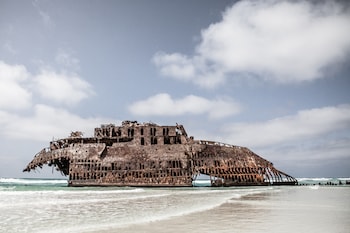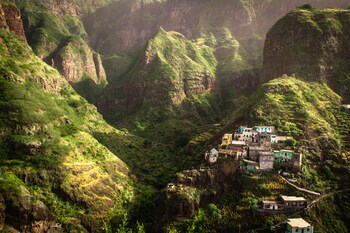Floating 310 miles (500km) off the coast of Senegal are the 10 laid-back landforms of Cape Verde. Blessed with great beaches and winter sun after only a six-hour direct flight from the UK, you can see why they have a reputation as “the African Caribbean”. However, the two archipelagos have more in common than palm trees and relaxation.
Perhaps not on first impressions, though. After touching down on the resort island of Sal, I drive through Mars-like terrain, passing perfectly cone-shaped volcanoes sprouting from the cumin-coloured rocks and sand. Tyres have been sliced in half and lined up in a row to form makeshift fences. Open-top jeeps cruise past us, GoPro-wielding tourists piled into the back.
But then I reach the peaceful port town of Palmeira to explore its basalt-cobbled streets. Its low-rise buildings colour-match the rich chalk palette of the fishing boats bobbing in its quiet harbour: cobalt, apple, violet. Street vendors proffering shell bracelets approach me, asking if I want “Africa selfies”, but they aren’t delivering the hard sell. An officer poses proudly for photos outside his police station like it’s a B&B. In the baking sun, people take afternoon naps on tangled mounds of fishing nets, and kids jump off the harbour wall wearing snorkels and clutching mini-harpoons, hopeful for a catch. Life is not easy here by any means – but this snapshot of life beside possibly the easiest-going harbour I’ve ever seen is my first taste of the Cape Verdean attitude to stress – i.e. that it’s completely pointless.
“No stress” are two words you won’t leave without hearing. A Cape Verdean turn of phrase delivered in a consoling tone, it’s synonymous with: “you’re welcome”, “I’ve got this”, and, “seriously, chill out!” It’s perhaps not the answer you want in response to a day-altering question, such as: “Will the ferry arrive today or tomorrow?” But it’s a promise of a gentler pace you get accustomed to.
Twenty minutes away from Palmeira on the southern tip of Sal lies the town of Santa Maria, with a comparatively buzzy strip of restaurants and al fresco bars. A striking contrast to the scenery in the north, the pristine white-sand crescent and turquoise-streaked waters of Santa Maria Beach could be in Barbados or the Bahamas. And the neighbouring resorts are where tourists settle for the week, ready for morabeza – the Cape Verdean brand of hospitality.

A street market in Cape Verde
Credit: GETTY
The islands were completely uninhabited until the Portuguese rocked up here in 1456 (at a time when Spain was setting up settlements left, right and centre in the Caribbean). Slaves from African countries were brought to Cape Verde, as well as families from the Azores, Madeira and other Portuguese settlements. As with the Caribbean’s creole culture, Cape Verde’s generations of blending of African and European nations has brewed to make its own languages, music and cuisine. Next year will mark 45 years of independence from Portuguese rule. Every July 5, there’s is an island-wide party, with dancers in feather epaulettes and carnival of floats on the island of Sao Vicente – Cape Verde’s musical and cultural hub, where Mardi Gras culminates in a colourful Shrove Tuesday parade (in line with Trinidad and Tobago’s spectacular “Fat Tuesday” festivities).
About 80 per cent of Sal’s ingredients are imported, presenting a mighty logistical challenge when it comes to feeding tourists – very little grows in this arid, salty environment. Instead, the sea delivers Sal’s bounty. I tuck into a delicious lunch moments from Santa Maria’s wooden pier at the aptly named LobStar Enjoyable Seafood Restaurant, where the lobsters emerge slathered in melted butter and a creole sauce (tomato, chili and bell peppers and garlic), and king prawns and fried squid are piled high onto plates.

Hilton Cabo Verde Sal Resort
Back at Hilton Cabo Verde Sal Resort, I sample an available-on-request meal of dishes with ingredients almost entirely sourced from Cape Verde’s islands. There’s goat’s cheese served with juicy papaya jam, refreshing wahoo ceviche lifted by coriander and fresh lime and a mousse made from kamoka (roasted maize flour, with a nougat-like flavour). Laced with pork and chorizo, Cape Verdean cachupa is not unlike Brazil’s feijoada – a hearty creole casserole dish, the product of another former Portuguese colony.
As with the Caribbean’s rum culture, Cape Verde’s lethal rum – aka “grogue” – is rooted in its colonial past. Sugar cane originally ended up in Cape Verde via the Caribbean during the 15th century, to be cultivated by slaves and exported as crops, but the Portuguese decided to make liquor, too. The rum-making process spurred local storytelling and musical rituals – producers would sing about family, love and beauty as they worked. Today, these themes live on in the nation’s emotionally charged morna music, made famous by the late barefooted diva, Cesaria Evora (whom Google honoured by illustrating its home page in her image for what would have been her 78th birthday this summer). After two rounds of caipirinhas at a Santa Maria beach shack – with lashings of grogue, a dash of lime and crystals of brown sugar – the whole world seems pretty relaxed.
Sal’s volcanic landscape has spawned intriguing underwater life. Rather than Technicolor coral reefs, the submarine side of the island is craggy, strewn with shipwrecks and caves. Guided by instructors from Hilton Cabo Verde Sal Resort’s watersports centre, I descend into the blue to the barnacled propellers of a fallen steamboat. Peach, lemon and lavender shoals commute around us; as we sit inside a cave, they form a curtain at its opening. We drift past gormless parrot fish and pencil-thin cornet fish, and peek into crevices to admire tiny neon nudibranchs. Manta rays and whale sharks can be spotted here, and Sal has the world’s third-biggest community of loggerhead turtles (nesting season lasts from June to October, when they’re most likely to float past you).

The island is craggy, strewn with shipwrecks and caves
Credit: getty
Travel between Cape Verde’s island is a luxury, with flights about €200 (£168) for a 20-minute hop, and the ferries aren’t necessarily reliable. But just as active types choose the Caribbean for its watersports and exciting landscapes, the island of Sal alone has enough to keep them busy. Kitesurfing is big here, and the reliable winds, calm waters and world-champion teachers of Kite Beach mirror the conditions of bays around the Caribbean (Sal’s kitesurfing season lasts from about November to April).
I spend an action-packed day with an excellent guide and driver exploring Sal’s distinctive sights. For the first time, I float in the buoyant, mineral-rich waters of a salt crater, paddle with baby lemon sharks as they rub against my shins like cats – and see my first desert mirage, teasing with a distant, non-existent lake. And I vow to come back and succumb to the charms of another Cape Verdean island – leaving all stress at home, where it belongs.

The verdant interior of Santo Antão
Credit: GETTY
How to do it
Cape Verde Experience (01489 866969; capeverde.co.uk) offers seven-night B&B packages at Hilton Cabo Verde Sal Resort from £1,159pp based on two sharing a King Guest Room (for departures on April 23 2020). The price includes direct flights from Gatwick to Sal, UK airport lounge access, luggage allowance, visa and private transfers. Island tours from €25pp.
For more travel inspiration, read Telegraph Travel’s guide to the best hotels in Cape Verde.
Source link : https://www.telegraph.co.uk/travel/destinations/africa/cape-verde/articles/cape-verde-winter-sun/
Author :
Publish date : 2019-12-16 08:00:00
Copyright for syndicated content belongs to the linked Source.





